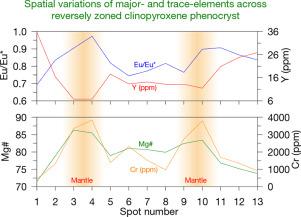Our official English website, www.x-mol.net, welcomes your
feedback! (Note: you will need to create a separate account there.)
Recycling of granulitic lower crust into the mantle
Lithos ( IF 2.9 ) Pub Date : 2020-12-01 , DOI: 10.1016/j.lithos.2020.105812 Jun-Bo Zhang , Yong-Sheng Liu , Wen-Li Ling , Rong Xu
Lithos ( IF 2.9 ) Pub Date : 2020-12-01 , DOI: 10.1016/j.lithos.2020.105812 Jun-Bo Zhang , Yong-Sheng Liu , Wen-Li Ling , Rong Xu

|
Abstract Foundering of eclogitic lower crust into the convecting mantle is a well-recognized process invoked to explain the relatively evolved chemical composition of Earth's continental crust. However, it remains unclear the extent to which the foundering could control the newly-made lowermost crust, and whether mafic granulite in a thickened eclogitic-granulitic lower continental section is effectively removable. Here we report a geochemical study of zoned clinopyroxene phenocrysts in Early Cretaceous high-Mg, Eu-depleted andesites (adakite-like intermediate lavas with high La/Yb and Sr/Y ratios and low heavy rare-earth element and Y contents) from the eastern North China craton (NCC), which suggests crust-to-mantle recycling of plagioclase-rich lithologies. Three types of zoned clinopyroxenes are recognized. The type I and II zoned clinopyroxenes show normal- and reverse-zonation, respectively, and both are featured by clear negative Eu anomalies in their cores. The type III zoned clinopyroxene is poikilitic with a high-Mg# core but no Eu anomaly, and enclosing low-Mg#, partially resorbed olivine grain. We therefore propose that these high-Mg andesites were derived from the partial melting of recycled plagioclase- and garnet-bearing granulitic lower crust, which have interacted with refractory peridotites at spinel-facies depth. Owning to mafic plagioclase- and garnet-bearing granulite with density higher and viscosity lower than refractory peridotite at the same temperature, the subcontinental granulitic lower crust could be preferentially recycled into the mantle through delamination. This correlates well with the continental Moho depth, as lower crustal xenolithes and geophysical studies in the eastern NCC revealed the existence of a granulite-facies rather than eclogite-facies lowermost crust residue (present-day ~30-km-thickness) with a pronounced Eu depletion (Eu/Eu* = ~0.8). Consequently, our preferred model has important implications for the compositional evolution of the Earth's continental crust, and offers new constraints on the scale and timing of lithosphere removal beneath the eastern NCC.
中文翻译:

麻粒质下地壳再循环进入地幔
摘要 榴辉岩下地壳形成对流地幔是一个公认的过程,用来解释地球大陆地壳相对演化的化学成分。然而,目前尚不清楚沉没对新形成的最下地壳的控制程度,以及加厚的榴辉岩-麻粒岩下陆剖面中的镁铁质麻粒岩是否可有效去除。在这里,我们报告了对早白垩世高镁、贫铕安山岩(具有高 La/Yb 和 Sr/Y 比率以及低重稀土元素和 Y 含量的埃达克岩中间熔岩)中的分带单斜辉石斑晶的地球化学研究。华北克拉通东部 (NCC),这表明富含斜长石的岩性存在壳幔循环。已识别出三种类型的分区单斜辉石。I 型和 II 型分带的单斜辉石分别显示正分带和反向分带,并且两者的特征都在其核心中具有明显的负 Eu 异常。III 型分带单斜辉石为变质岩,具有高 Mg# 核但没有 Eu 异常,并包含低 Mg#、部分再吸收的橄榄石颗粒。因此,我们提出这些高镁安山岩来源于再生的含斜长石和石榴石的麻粒质下地壳的部分熔融,这些下地壳与尖晶石相深度的难熔橄榄岩相互作用。由于含镁铁质斜长石和含石榴石的麻粒岩在相同温度下比难熔橄榄岩密度高、粘度低,次大陆麻粒质下地壳可以通过分层优先回收进入地幔。这与大陆莫霍面深度相关,由于在华北克拉通东部的下地壳捕虏体和地球物理研究表明存在麻粒岩相而不是榴辉岩相下地壳残留物(现今~30 公里厚),具有明显的 Eu 消耗(Eu/Eu* = ~ 0.8)。因此,我们首选的模型对地球大陆地壳的成分演化具有重要意义,并为 NCC 东部下方岩石圈移除的规模和时间提供了新的限制。
更新日期:2020-12-01
中文翻译:

麻粒质下地壳再循环进入地幔
摘要 榴辉岩下地壳形成对流地幔是一个公认的过程,用来解释地球大陆地壳相对演化的化学成分。然而,目前尚不清楚沉没对新形成的最下地壳的控制程度,以及加厚的榴辉岩-麻粒岩下陆剖面中的镁铁质麻粒岩是否可有效去除。在这里,我们报告了对早白垩世高镁、贫铕安山岩(具有高 La/Yb 和 Sr/Y 比率以及低重稀土元素和 Y 含量的埃达克岩中间熔岩)中的分带单斜辉石斑晶的地球化学研究。华北克拉通东部 (NCC),这表明富含斜长石的岩性存在壳幔循环。已识别出三种类型的分区单斜辉石。I 型和 II 型分带的单斜辉石分别显示正分带和反向分带,并且两者的特征都在其核心中具有明显的负 Eu 异常。III 型分带单斜辉石为变质岩,具有高 Mg# 核但没有 Eu 异常,并包含低 Mg#、部分再吸收的橄榄石颗粒。因此,我们提出这些高镁安山岩来源于再生的含斜长石和石榴石的麻粒质下地壳的部分熔融,这些下地壳与尖晶石相深度的难熔橄榄岩相互作用。由于含镁铁质斜长石和含石榴石的麻粒岩在相同温度下比难熔橄榄岩密度高、粘度低,次大陆麻粒质下地壳可以通过分层优先回收进入地幔。这与大陆莫霍面深度相关,由于在华北克拉通东部的下地壳捕虏体和地球物理研究表明存在麻粒岩相而不是榴辉岩相下地壳残留物(现今~30 公里厚),具有明显的 Eu 消耗(Eu/Eu* = ~ 0.8)。因此,我们首选的模型对地球大陆地壳的成分演化具有重要意义,并为 NCC 东部下方岩石圈移除的规模和时间提供了新的限制。











































 京公网安备 11010802027423号
京公网安备 11010802027423号